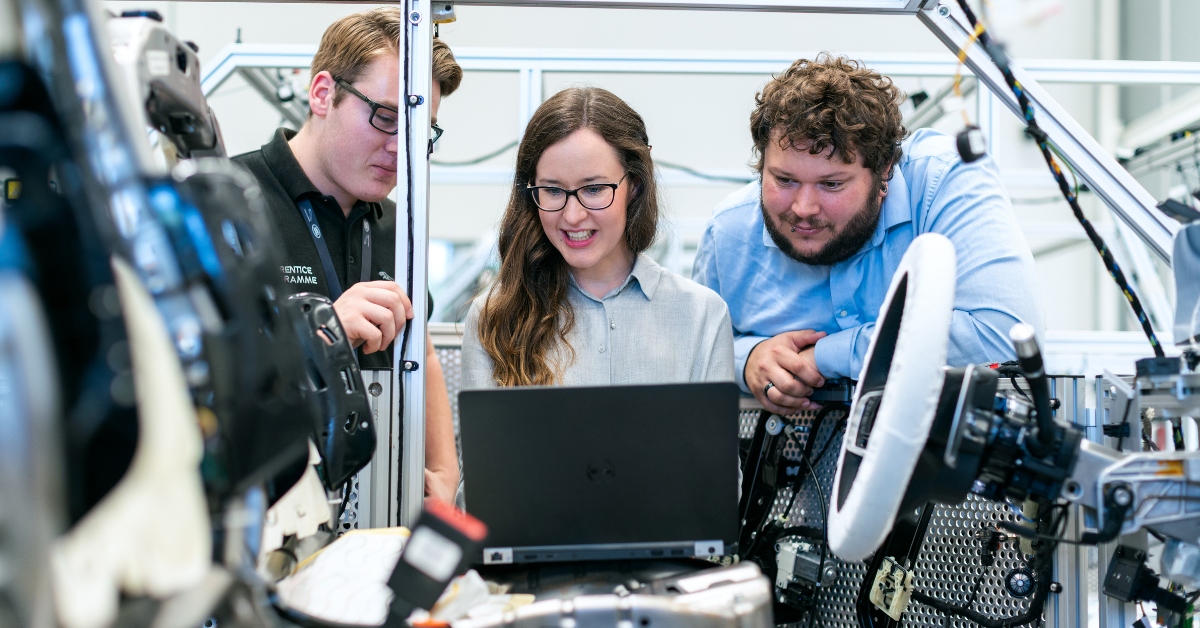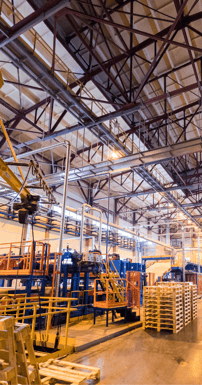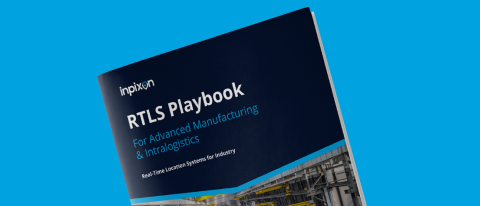With Industry 4.0, being able to determine where your assets are and when they move across your facilities greatly improves visibility over operations, and helps inform important decisions that reduce costs and boost ROI. When looking into Real-Time Location Systems (RTLS) or ranging solutions for your organization, there are different radio-frequency (RF) types and methodologies that can be used and combined to best match desired outcomes.
In this post, we’ll go over the different types of RF technologies that power real-time location systems, & how they work together to expand & create synergies that solve real world problems.

Ultra-Wideband RTLS
Ultra-Wideband (UWB) is a cutting-edge RF technology that delivers precise location information in an RTLS, known best for its centimeter level accuracy and reliability, operating on a high bandwidth over a wide frequency spectrum.
How UWB Works
UWB positioning is precise because of its ability to transmit very high data rates over short ranges. It mainly works by Time-Difference of Arrival (TDoA), a methodology for location tracking. Because TDoA can process thousands of blinks received simultaneously, it works well with enterprise grade deployments. UWB can also be used with Two Way Ranging (TWR), another methodology used to determine the relative position of an object by enabling communication between two devices.
Key Characteristics and Use Cases for UWB
UWB is a highly reliable RF technology that can pinpoint the location of assets within +/- 40 centimeter accuracy in near real-time. It generally has strong protection against interference and consumes very low power, proving to be an affordable option as some hardware can go years without needing to be replaced. UWB is best suited for precise indoor tracking over shorter ranges (0-50 meters), and would need more anchors to cover larger areas.
UWB is best used in situations that require a high degree of precision and accuracy, for example pinpointing the exact location of an object as it moves through an assembly line in a smart factory. It can also be used to track workers wearing personnel tags, and enable the location awareness used for proximity messaging, geofencing and indoor navigation. In addition, the accuracy of location data is key in identifying bottlenecks to optimize workflows.
Chirp Spread Spectrum (CSS) RTLS
Chirp Spread Spectrum, also referred to as chirp, is a unique RF technology used for RTLS applications and is known for its advantages in range and reliability.
How Chirp Works
Chirp can leverage location tracking (TDoA) or two-way ranging to transmit location information in a RTLS at meter-level accuracy. Because Chirp functions on a lower frequency, it's also used for its reliability and strong protection against interference, especially in safety situations.
Key Characteristics and Use Cases for Chirp
Chirp is unique in the way it provides long ranging from 10-500 meters and up to 1000 meters in optimal conditions. This, along with its ability to work outdoors in addition to indoors, opens up the possibility to be used in a variety of use cases such as tracking livestock or the movement of equipment across large facilities.
Another benefit to chirp is that unlike other RF types, organizations do not require a spectrum license for outdoor tracking and therefore don’t have to worry about regulatory compliance issues. Chirp’s long ranging also means there are fewer anchors required in deployments, allowing it to be a lower cost option among RF types. Its reliability and low frequency are utilized in industrial environments such as mining, where strong protection against interference is crucial.
Bluetooth Low Energy (BLE) RTLS
Bluetooth Low Energy, or BLE, is a widely used radio-frequency (RF) technology for wireless communication, which can be leveraged to track the location of assets or people in a given space.
How BLE Works
BLE leverages BLE-enabled sensors or beacons (hardware which emit Bluetooth signals) to detect and locate Bluetooth devices. Like Wi-Fi, Bluetooth’s main method in transmitting signals is by Received Signal Strength Indicator (RRSI). Through RSSI, devices containing RTLS sensors can detect the received strength of the signal from a device, in which location data is collected and sent to a location engine to determine a location using multilateration.
Key Characteristics and Use Cases for BLE
Bluetooth has a large presence in wireless devices, smartphones and wearables, making it a popular RF type. Because BLE beacons are so small, they can be placed on fixed infrastructure or mobile assets, supporting a range of use cases such as mobile payments, smart tags at airports, door entry access control and more. This supports communication between devices through proximity messaging by sending relevant content to users based on the time or their location.
For example, in a retail setting, BLE beacons would be placed in a store and if a customer had an app for the same store and walked into it, they could receive a message with a special offer or discount. BLE was also used during the pandemic, where many countries had apps that would inform users if they had come within range of someone that had been infected with COVID-19 using BLE between devices.
However, with RSSI based tracking, Bluetooth does not work over large ranges - it mainly covers a range of 0-25 meters. Think of when headphones are connected to a smartphone - the further the user moves away from their phone, the weaker the connection becomes. This can turn costly, as more infrastructure would be required to cover a longer distance. BLE is also subject to interference, making it less reliable than other RF types unless a large network of Bluetooth Beacons is installed for the IPS. This is why situations where 2-4 meter-level (room level) accuracy is sufficient, are most suitable for BLE.
Wi-Fi RTLS
Wi-Fi is the most widely used RF type, making it important in many RTLS applications. Like BLE, Wi-Fi uses RSSI for positioning, but it differs in many other ways such as range.
How Wi-Fi Works
Wi-Fi works with RSSI, using the strengths of signals to determine the distance of a user from a Wi-Fi access point. To make this system work, both Wi-Fi access points and Wi-Fi enabled sensors are needed in order to transmit location information. It is similar to users having a Wi-Fi router (access point) and smartphone (with a Wi-Fi enabled sensor) in their home, except at a larger scale for an RTLS. In some cases, more advanced Wi-Fi positioning methods are used such as Angle of Arrival (AoA) and Time of Flight (ToF).
Key Characteristics and Use Cases for Wi-Fi
Because Wi-Fi is used with most smartphones and mobile devices, it’s a great way to get started with IPS through already existing Wi-Fi access points and infrastructures. Wi-Fi offers accuracy of under 10 meters and a range of 0-50 meters, using moderate power consumption. Because of its use of RSSI, it may have weaker protection against interference, and more access points would need to be installed to cover a large range. Compared to UWB and chirp, which have a latency of less than a millisecond, it typically takes Wi-Fi RTLS 3-5 seconds to receive location information.
Wi-Fi does have higher power and accuracy than BLE, allowing more operational distance. Just like a wireless device connected by Bluetooth compared to Wi-Fi, Bluetooth offers users limited motion before the connection stops while Wi-Fi maintains the connection for longer. Wi-Fi is most suitable for use cases in wireless intrusion detection, blue dot wayfinding with turn-by-turn navigation, proximity messaging, asset tracking and more.
Radio-Frequency Identification (RFID)
RFID is another RF type that is electromagnetic field based. Not only is it used with RTLS, but it's a form of wireless communication used in everyday life, such as with contactless payments, hotel room access, inventory tracking and more.
How RFID Works
There are two types of RFID: Active RFID and Passive RFID. While passive RFID enables short range positioning and receives its power from an antenna using electromagnetic waves, active RFID works over longer ranges and has its own power source, which is most commonly a battery.
Key Characteristics and Use Cases for RFID
RFID generally operates with 1 meter accuracy, over a range of 0.5-3 meters for passive RFID scanners and up to 10 meters and more for active RFID. Passive tags usually have no battery and are a low-cost option if only identification and a low range is required. Active RFID is more costly since each tag has its own battery. But because RFID tags are only used once triggered by a signal and are ‘off’ the rest of the time, their battery life can be quite long.
RFID allows for data about an object to be saved to its tag, which is useful in hospital or retail settings to track merchandise or equipment. It’s also suitable for theft prevention, so when a high value tagged item passes through a reader when leaving the store, it can trigger an alarm.
Useful Synergies in RTLS and Ranging
UWB & Chirp
UWB has strengths in accuracy, reliability and wide availability in the market, however its limited outdoor capabilities and range means UWB is most effective when paired with chirp RF technology. By combining the long ranging and outdoor use case of chirp with UWB’s precise asset tracking, it expands the possibilities of what an RTLS can accomplish and makes it highly scalable.
Indoor and Outdoor Tracking
In a smart warehouse, yard management or manufacturing, chirp can be enabled to track outdoor vehicles, security guards and processes as they move across large facilities, while UWB can provide the precise location of specific equipment and merchandise with centimeter accuracy.
This is also suitable in situations such as search and rescue, where the outdoor capabilities of chirp can help determine the general position of people in a fire while outside, and UWB can help pinpoint the exact location of people indoors as soon the search and rescue team approaches the estimated location inside the building.
Hospitals and Healthcare
In certain settings, it might not be necessary to have precise indoor tracking with UWB in every single room. For example, a hospital may decide that 1-2 meter tracking with chirp is suitable for general waiting rooms or finding equipment like infusion pumps and respirators, while precise tracking would be useful to distinguish whether patients are in their own hospital bed or already on the operating table (which changes the cost of this patient. In addition, this would help determine which operating rooms are being used, benefiting workflow optimization in a high stakes environment.
To make this work, tags with both UWB and chirp technology are needed, plus different anchors in different rooms, depending on what kind level of precision is needed for location tracking in that room.
Chirp & UWB with RFID
Mining
In industrial settings such as mining, chirp is a great RF technology that can be used to track personnel, equipment and large machinery, because of its long ranging and strong protection against interference as it functions on a low bandwidth. A combination of Chirp and RFID could therefore work as a cost-effective combination to track devices of a lone worker descending into a mine.
Smart Warehousing
In a large warehouse or a manufacturing area potentially combined with outdoor yard management, the long ranging of chirp can be used to track tagged forklifts. But because forklifts often carry multiple large pallets, it can be difficult to pinpoint an exact asset among a large pile or the exact position of a pallet. In this case, asset identification could be added via RFID-tagged pallets, so that someone scanning an entire column of pallets with an RFID reader can hear the reader set off a sound when it encounters the right tag being tracked.
Therefore, with a combination of RFID and UWB or chirp, accurate shelf identification is made possible for pallets, bins boxes, and various other objects being carried by forklifts. Warehouses with an RTLS can also use UWB for the precise location of a forklift to benefit traffic management and route optimization in their facilities. When objects are tagged, having the real-time location of forklifts makes the process of finding or storing pallets easy, especially with the pallet's digital twin being accessible on a dashboard.
BLE, Wi-Fi, GPS & IMU
BLE is generally a good technology to configure devices via the omnipresent wireless communication available on cellphones, to allow intuitive interaction with the devices for setup, configuration and maintenance.
Wi-Fi can be used in some installation settings to replace the Ethernet cables of anchors with a wireless data backbone - however it adds some unreliability that needs to be acceptable for that specific deployment.
Other technologies like GPS and inertial measurement units (IMU) can add value for specific needs at the edges of the deployment areas where the RTLS infrastructure is not 100% available. These additional data points add speed or add to the position information of tagged objects and can help to refine the location data for subsequent triggered actions.
Ranging & Tracking (UWB or Chirp)
There are different methodologies used to achieve location awareness in a given space. While some organizations require precise location data and visibility over their entire facilities, some may require location awareness to help with quick decision making in safety scenarios.
Time-Difference of Arrival (TDoA), is a methodology for location tracking, which calculates the position of a tagged object by analyzing the different times of arrival of the signals sent from RTLS tags to fixed anchors. On the other hand, two-way ranging (TWR) works as two tagged objects in range of each other are sending each other signals or ‘chirps.’ The relative position of the objects is then determined by getting the time it takes for signals to travel between the tagged objects and multiplying it by the speed of light.
Inpixon offers the unique ability to combine both ranging and location tracking to meet a wide variety of needs. Some organizations may opt to invest in ranging to meet safety regulations but decide to add location tracking to benefit from a holistic view over their operations.
Location Awareness is the Future
There are various use cases for RTLS and ranging, whether that be tracking specific merchandise in a warehouse, improving worker safety in a mine or preventing theft in a retail store. Figuring out which location technology best matches the needs of your organization can be a challenging task, but we’re here to help. Interested in learning more about RTLS? Watch our webinar on Top 5 RTLS Challenges and How to Fix Them or contact us today.



-3.png?length=1000&name=Inpixon%20LinkedIn%20Banner%20August%202025%20(2)-3.png)

